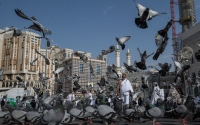
The Pigeons of the Grand Mosque , also known as 'pigeons of al-Hema' and referred to by the residents of Makkah as 'pigeons of the Household,' are the pigeons of Makkah al-Mukarramah and a distinctive feature of the city. These pigeons are treated with special care, and it is prohibited for anyone, whether in the state of Ihram or not, to kill or disturb them. Poets have often sung about the pigeons of the Grand Mosque in their poems, and they have become a symbol in various...
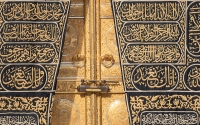
Sadanat al-Kaaba (al-Kaaba Caretaking) is the process of serving and maintaining al-Kaaba al-Musharrafa, which the Prophet Muhammed (PBUH) delegated to the Banu Talha tribe, known today as Al Shaibi. The state chooses one caretaker of al-Kaaba from the family and has one delegate. The caretaker receives the Kiswa (the cloth covering al-Kaaba) on the day of Eid al-Adha before changing it on the first day of Muharram every year. Dimensions of the term Sadanat al-Kaaba The term Sadanat al-Kaaba ...
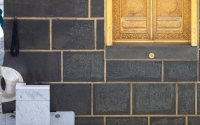
Al-Kaaba's Multazam is a part of al-Kaaba al-Musharrafa and a landmark of the Grand Mosque in Makkah al-Mukarramah. it is located on the eastern wall situated between the Black Stone set into the corner and the door of al-Kaaba. Some say it refers to the entire length of the east wall of al-Kaaba. It's a place where people cling to make supplications between the Black Stone and the door of al-Kaaba al-Musharrafa. Designation of al-Kaaba's Multazam The term Multazam is a linguisti...
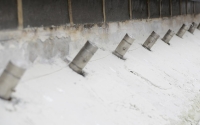
Al-Kaaba's Shadherwaan is the white marble belt that surrounds the lower part of al-Kaaba al-Musharrafa's wall at the level of circumambulation. It is called Taazir because it resembles an Izaar (a traditional lower garment worn by men). It is distinguished by its elevated design on the western, southern, and eastern sides, along with its gold rings that are attached to al-Kaaba's Kiswa below its wall on all sides except the northern side and below the door of al-Kaaba. Kaaba Sha...
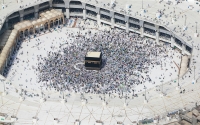
The Mataf of the Grand Mosque refers to the marble area surrounding al-Kaaba al-Musharrafa within the Grand Mosque. It is also called Sahn al-Mataf . In this area, Muslims perform their circumambulation ( Tawaf ) around the sacred al-Kaaba al-Musharrafa at all times, day and night. There are different types of Tawaf, which include: Tawaf al-Umrah, Tawaf al-Qudum for Hajj, Tawaf al-Ifadah , a pillar of Hajj, Tawaf al-Wadaa , and Tawaf al-Tatowe . Mataf flooring in the Grand Mosque The flooring o...
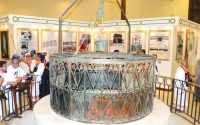
Zamzam Well is a well located in the Grand Mosque in Makkah al-Mukarramah, near al-Kaaba al-Musharrafa. It is the source of Zamzam water, which the Prophet Muhammad, peace be upon him (PBUH), described as blessed water and stated that it is a cure for diseases. Location of Zamzam Well Zamzam Well is located within the Mataf area in the Grand Mosque in Makkah al-Mukarramah, west of the Kingdom. It is positioned on the eastern side of al-Kaaba al-Musharrafa, approximately twenty-one m away, and a...
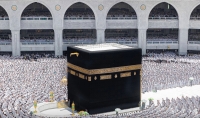
The Saudi Riwaq is the name given to the expansion of the Mataf area in the Grand Mosque in Makkah al-Mukarramah . It was named in honor of the Kingdom of Saudi Arabia, which has been responsible for constructing and maintaining this section since the era of King Abdulaziz Bin Abdulrahman Al Saud , continuing through to the reign of the Custodian of the Two Holy Mosques King Salman Bin Abdulaziz Al Saud. History of the Mataf expansion in the Saudi era The expansion of the Mataf area began durin...
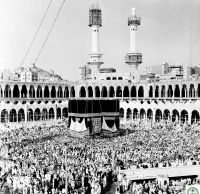
The First Saudi Expansion of the Grand Mosque encompasses the courtyards and structures added to the Grand Mosque in Makkah al-Mukarramah during the early years of the Saudi era, as well as the reforms within the Grand Mosque, such as its first electrification for full lighting, the assembly of worshipers behind a single imam , and the assignment of dedicated guards for the Black Stone. It was initiated by the Founding King Abdulaziz Bin Abdulrahman Al Saud during his reign, and was continued b...
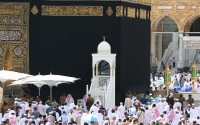
The Grand Mosque Minbar (pulpit) is a slightly higher place designated for the khatib (preacher) of the Grand Mosque, on which he ascends at noon each Friday to perform the khutbah (sermon) . It is one of the most prominent features of the Grand Mosque. Its uniqueness lies in the fact that it is movable. Many sermons and directives recited by the preachers of the Grand Mosque bore the name of this minbar. It is one of the most prominent Islamic platforms that attract interest from followers and...
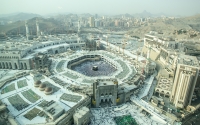
The Courtyards of the Grand Mosque are the courtyards surrounding the Grand Mosque from all sides, separating it from hotels and services in the central area of Makkah al-Mukarramah. They are used for prayer and to break the fast for those who are fasting. During times of overcrowding, such as the month of Ramadan, they provide all of the services available in the Grand Mosque, such as mattresses, Zamzam water, and the Quran. The courtyards of the Grand Mosque feature secure deposit boxes that ...

The Kiswa of the Holy Kaaba is manufactured at King Abdulaziz Complex for Kiswa, located in Makkah, Kingdom of Saudi Arabia. The complex was previously called the Kiswa Factory of the Holy Kaaba until 2018, the Custodian of the Two Holy Mosques, King Salman bin Abdulaziz al-Saud, amended its name to King Abdulaziz Complex for Kiswa in honor of the founding King Abdulaziz bin Abdulrahman al-Saud, who established the first institution dedicated to the sewing of the Holy Kaaba's Kiswa during ...

The area of the Grand Mosque after the completion of the projects in the third Saudi expansion north of the Holy Mosque in Makkah is approximately 1,371,000 m 2 . Its prayer halls can accommodate around 1,700,000 worshipers. The area of the Grand Mosque is distributed across its indoor prayer halls, outdoor courtyards, various floors, expansions, the Mataf and Masaa areas, and the roofs. The courtyards of the Grand Mosque are known for providing all the necessary services for the visitors and p...